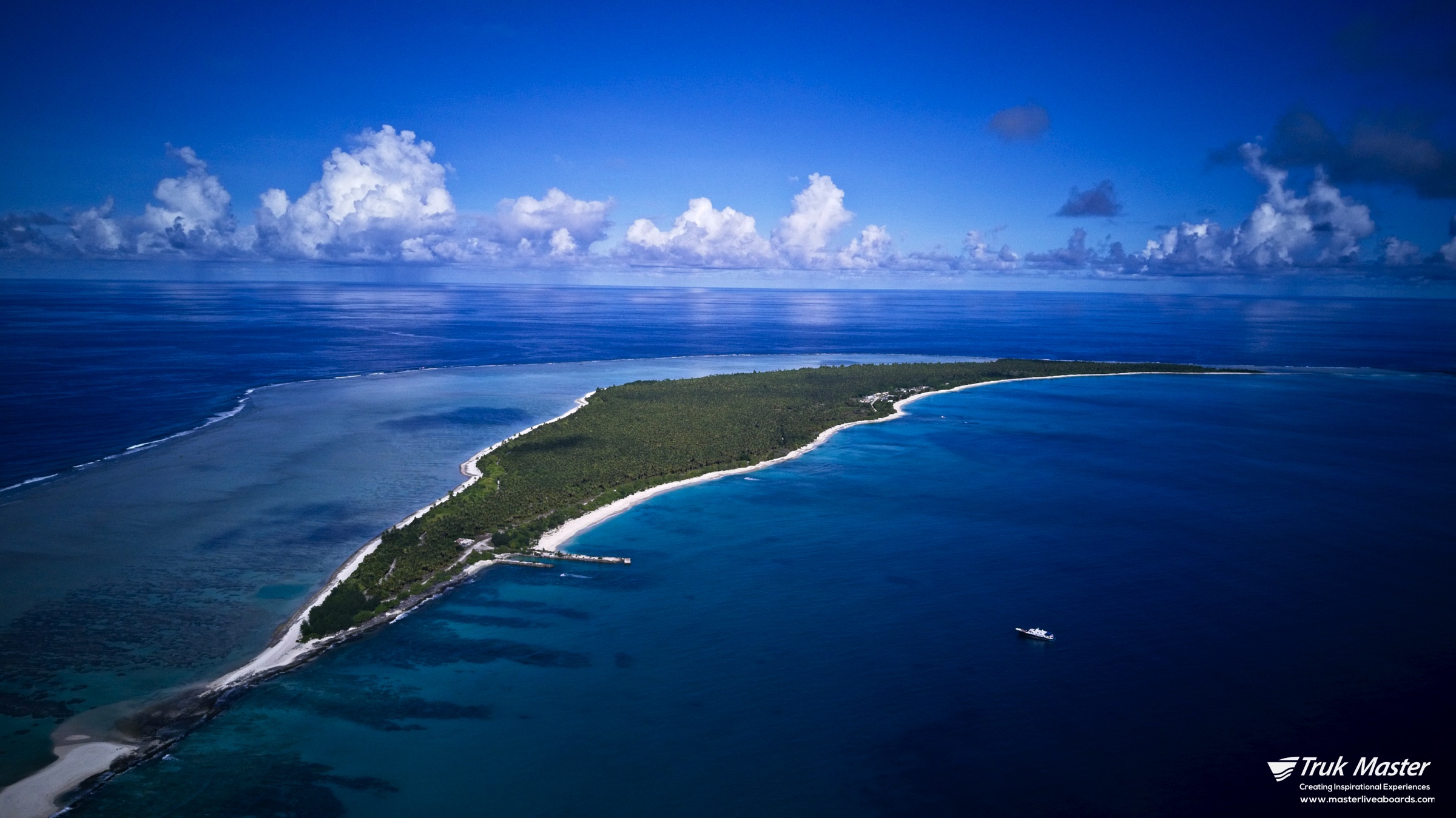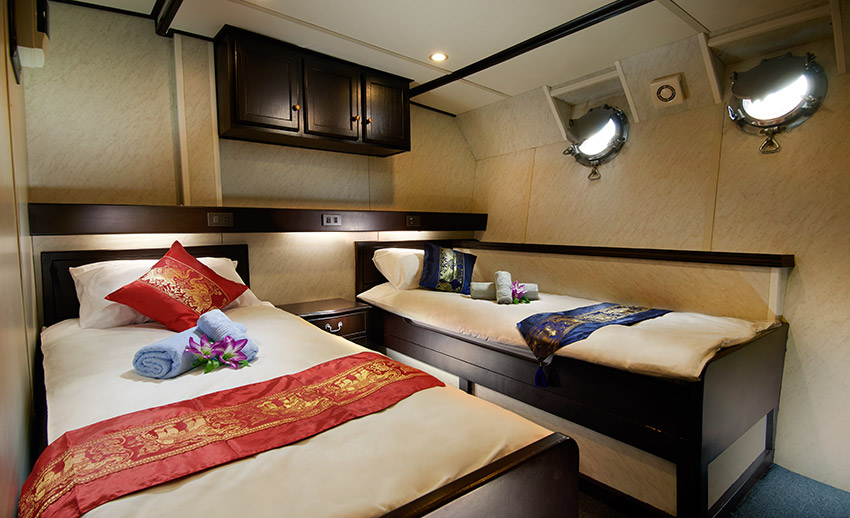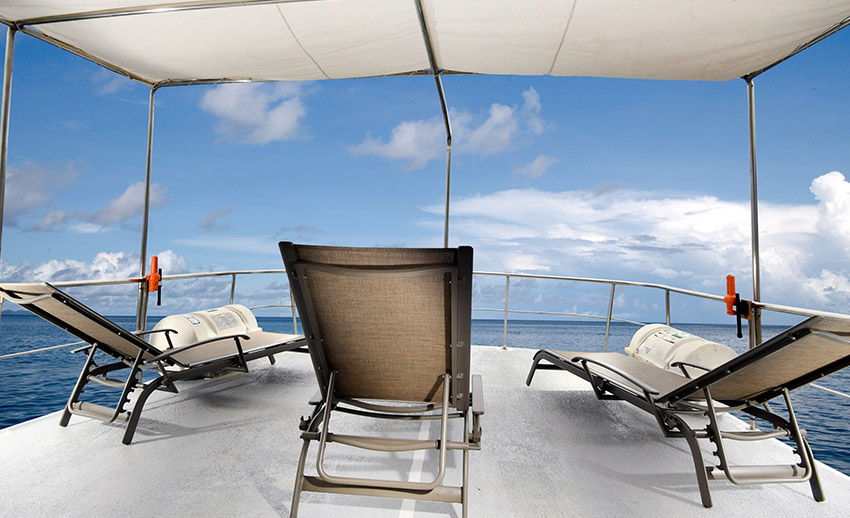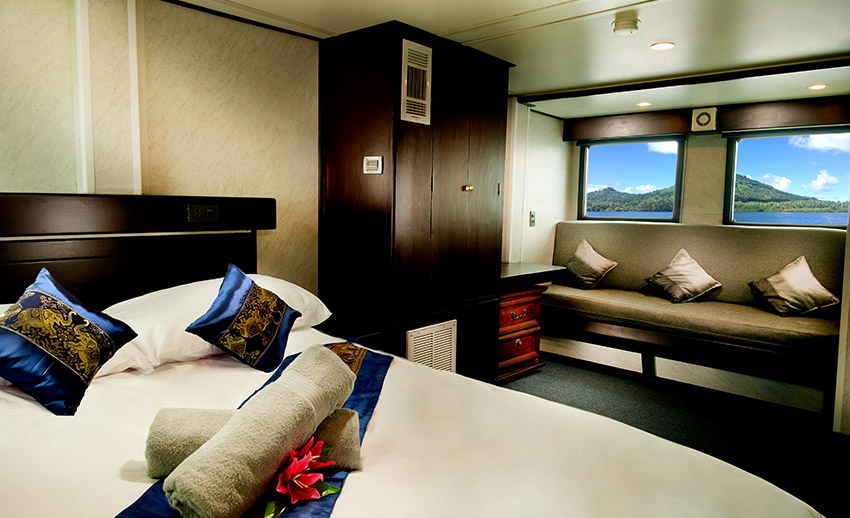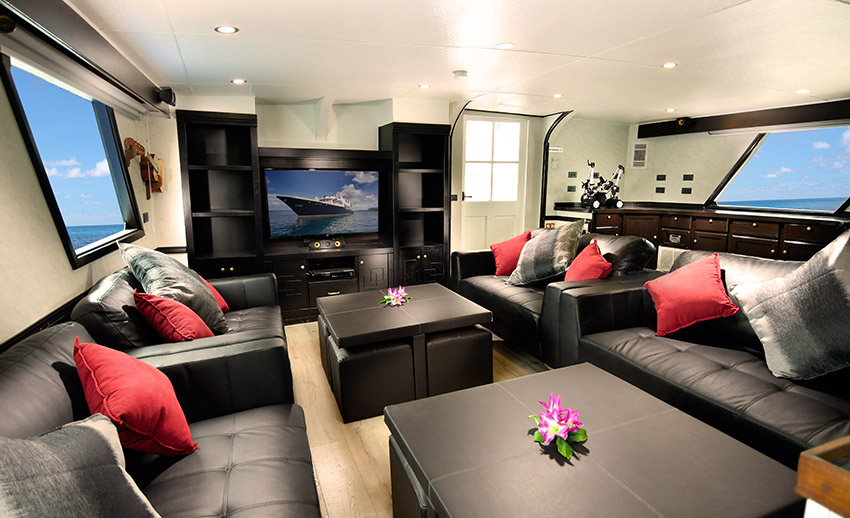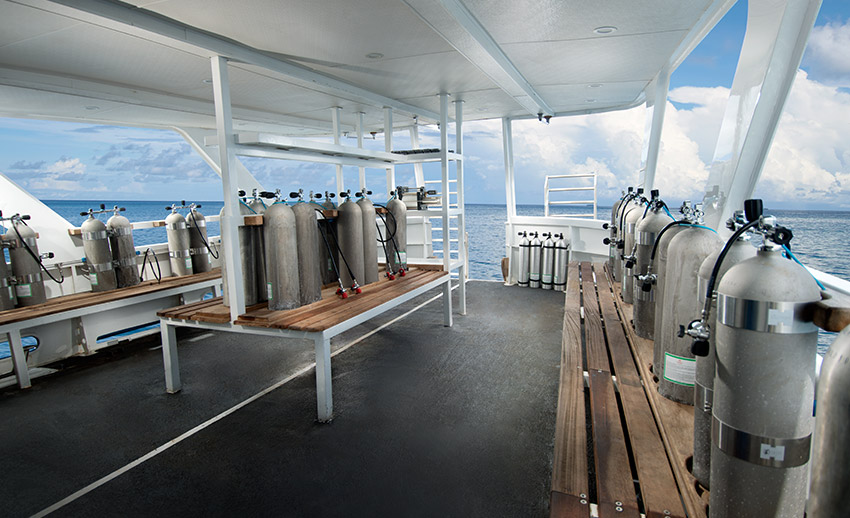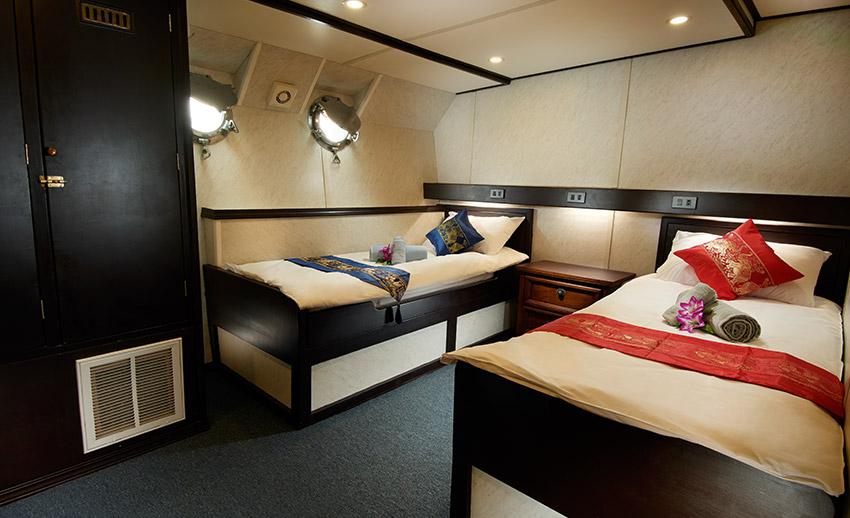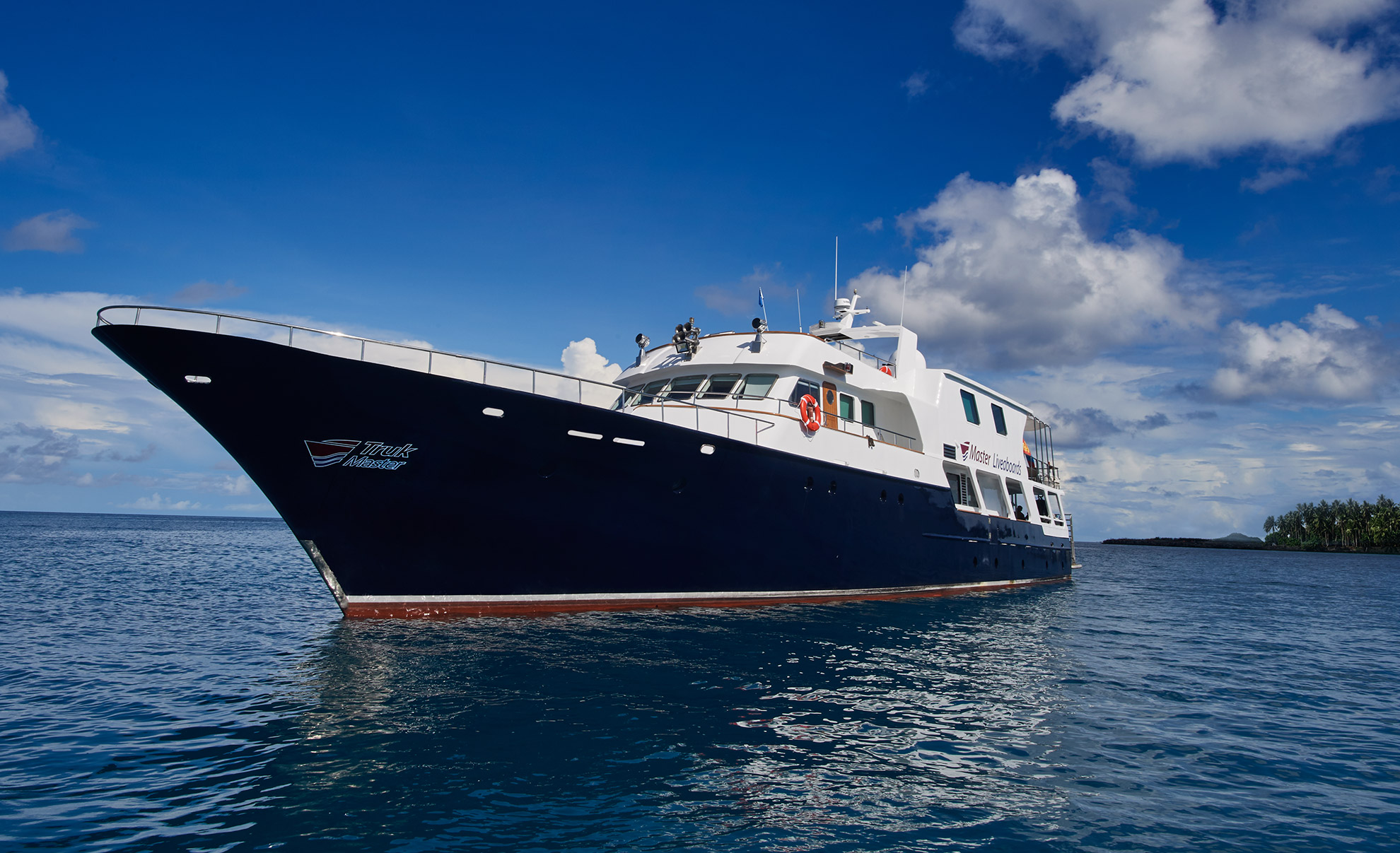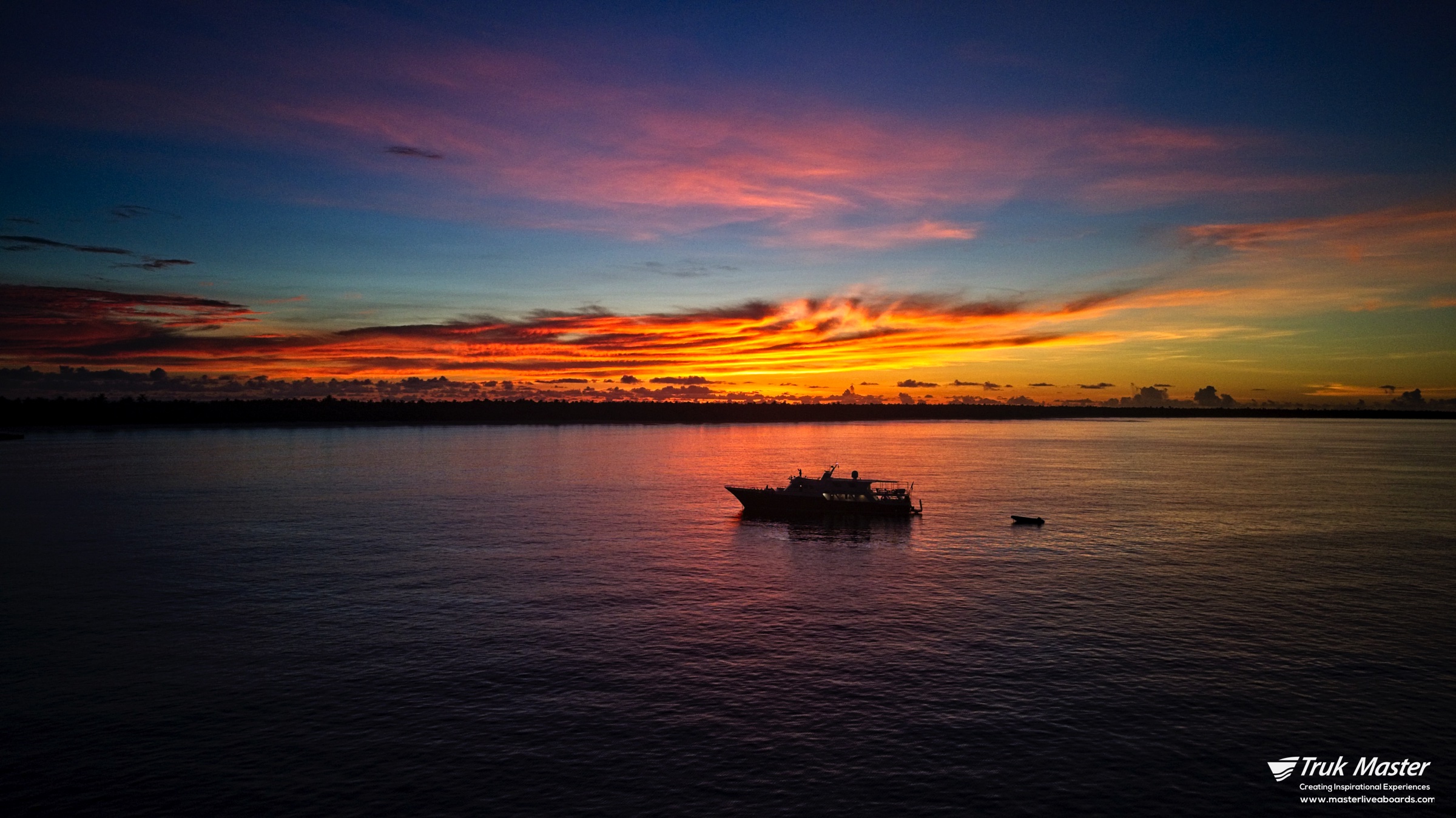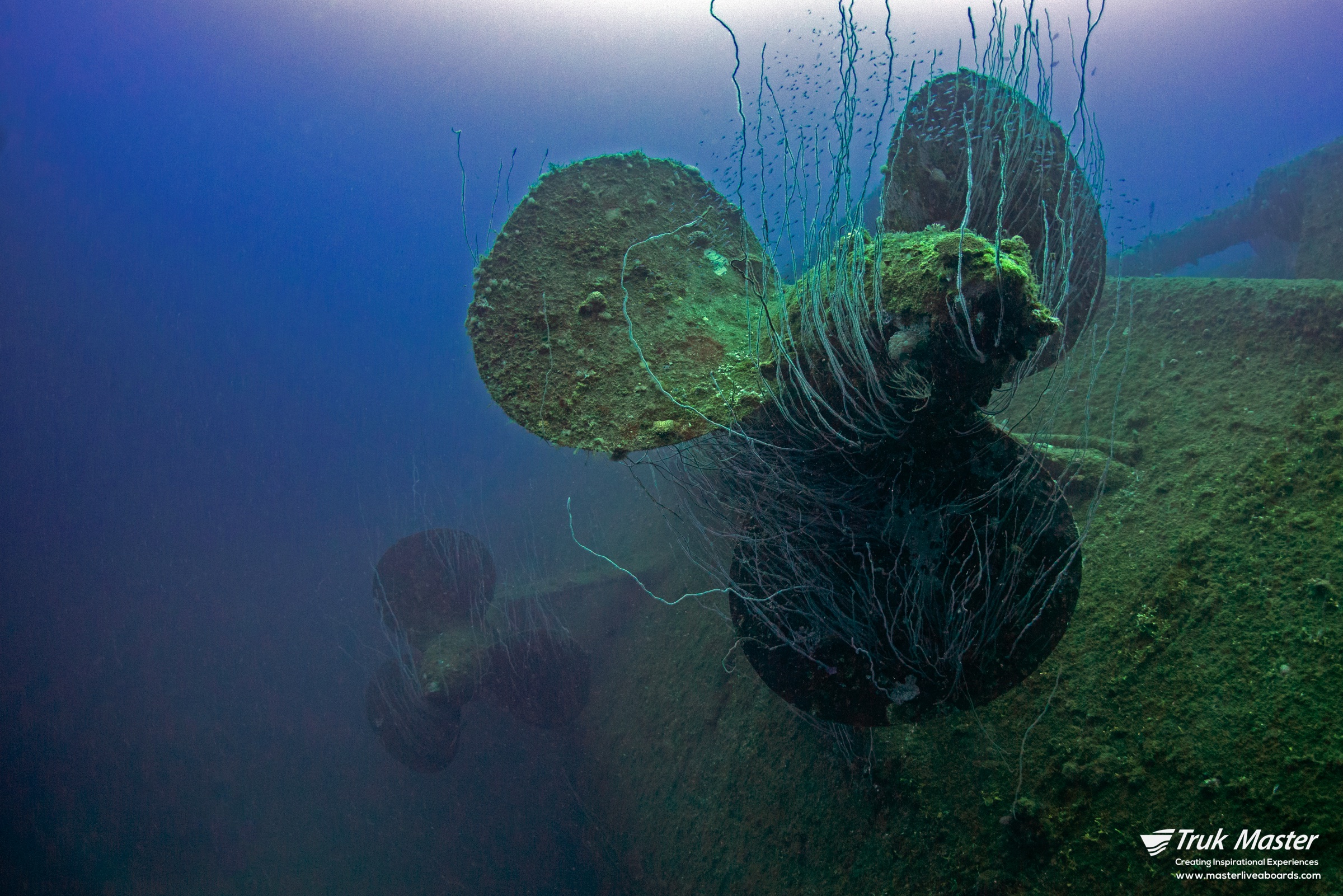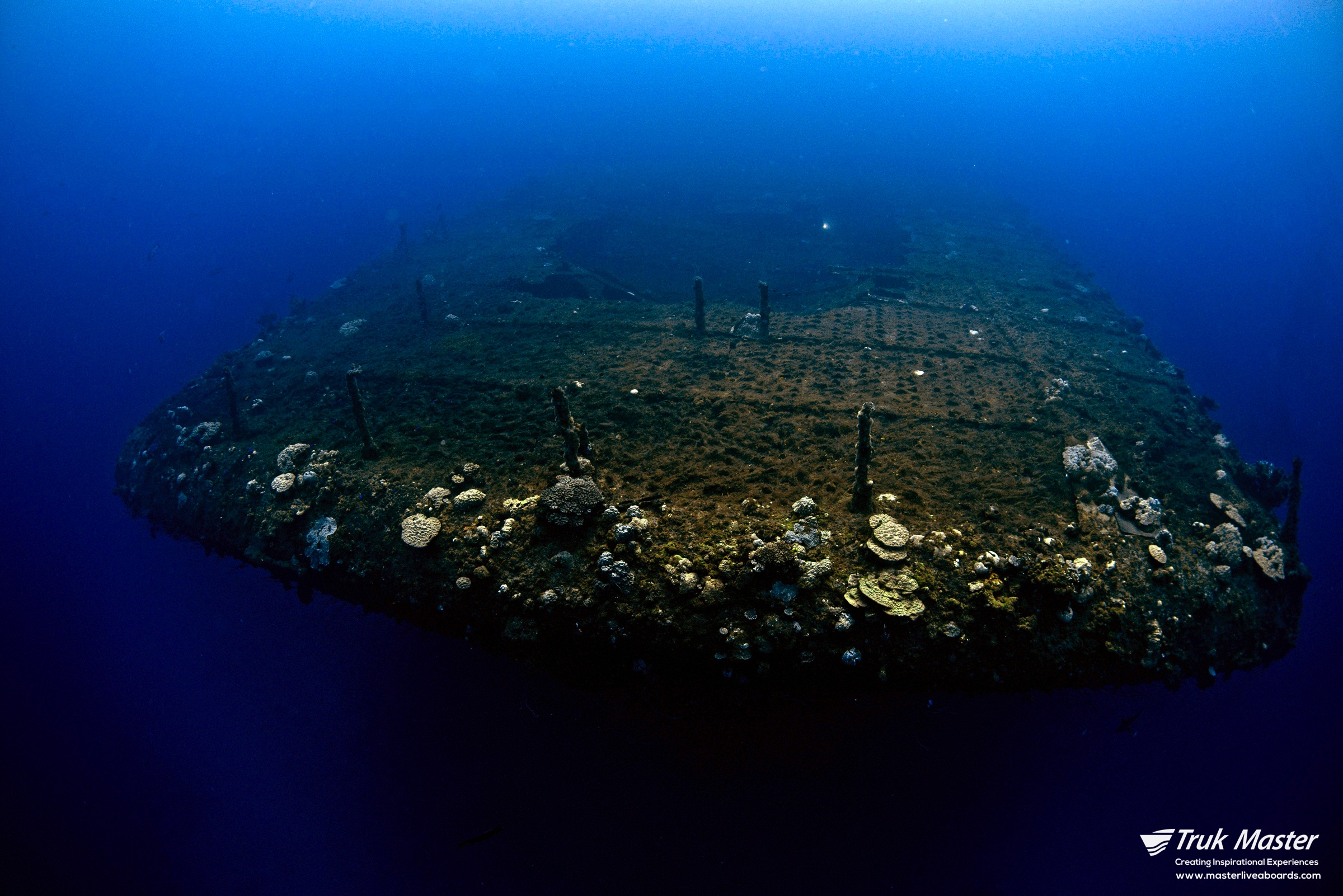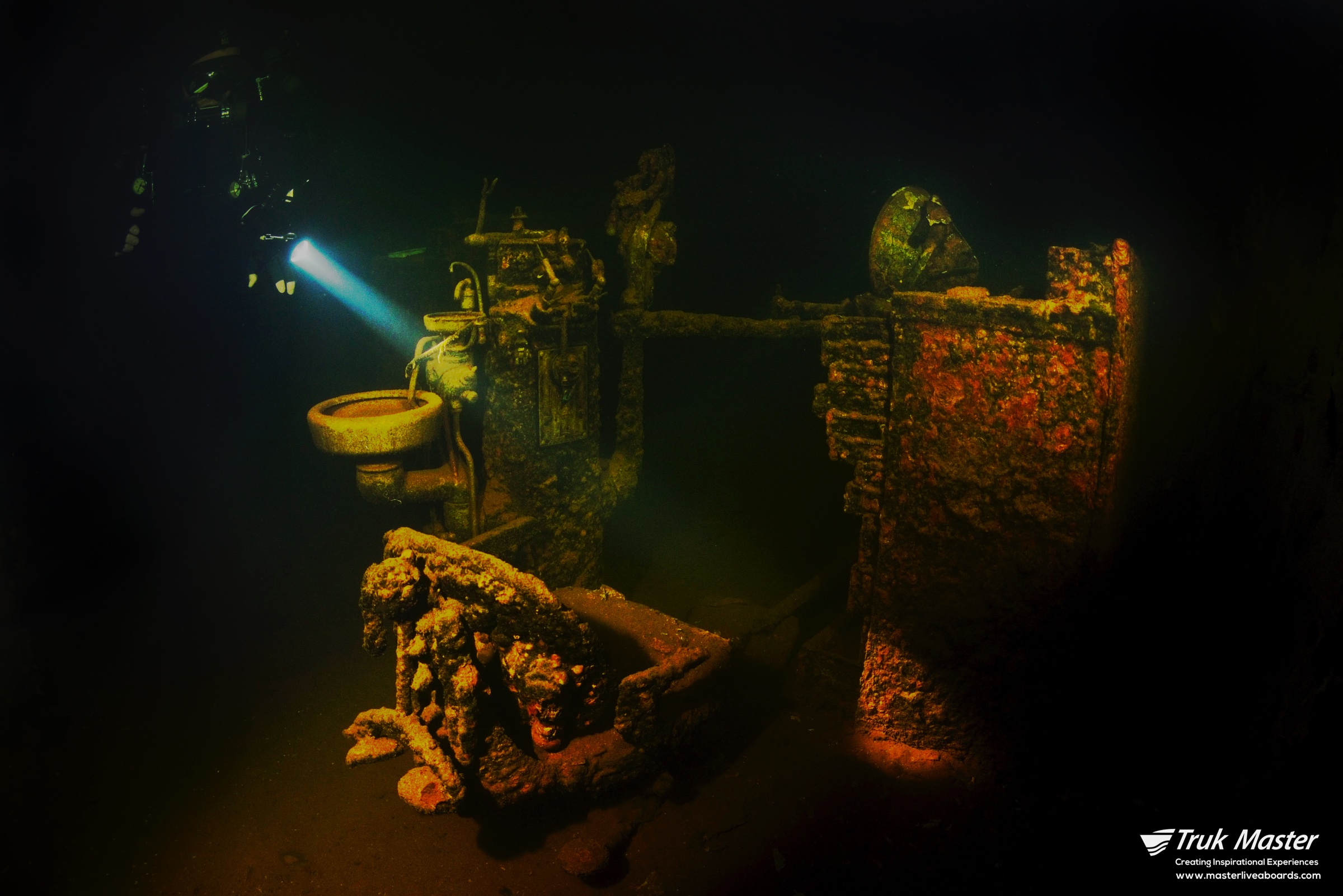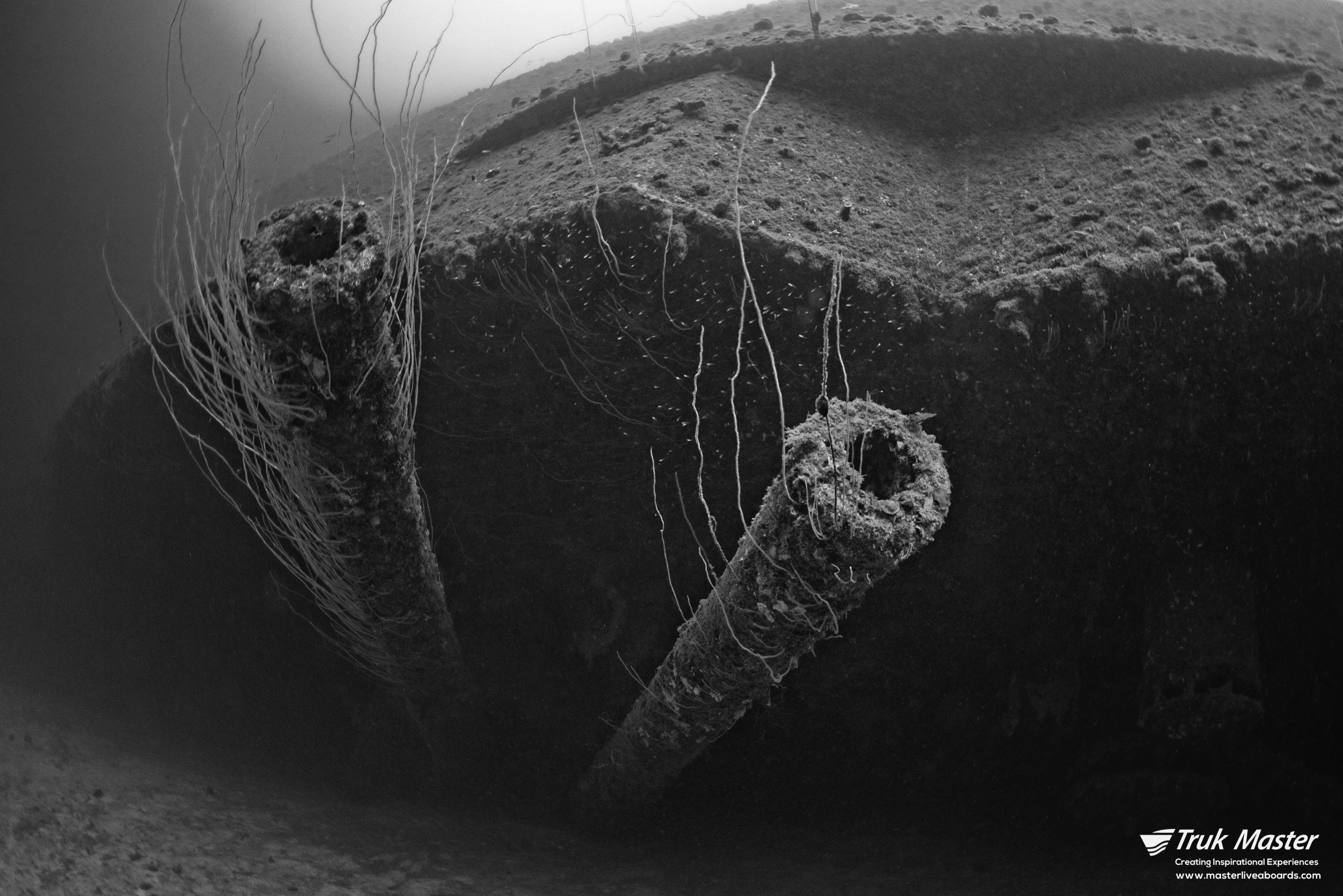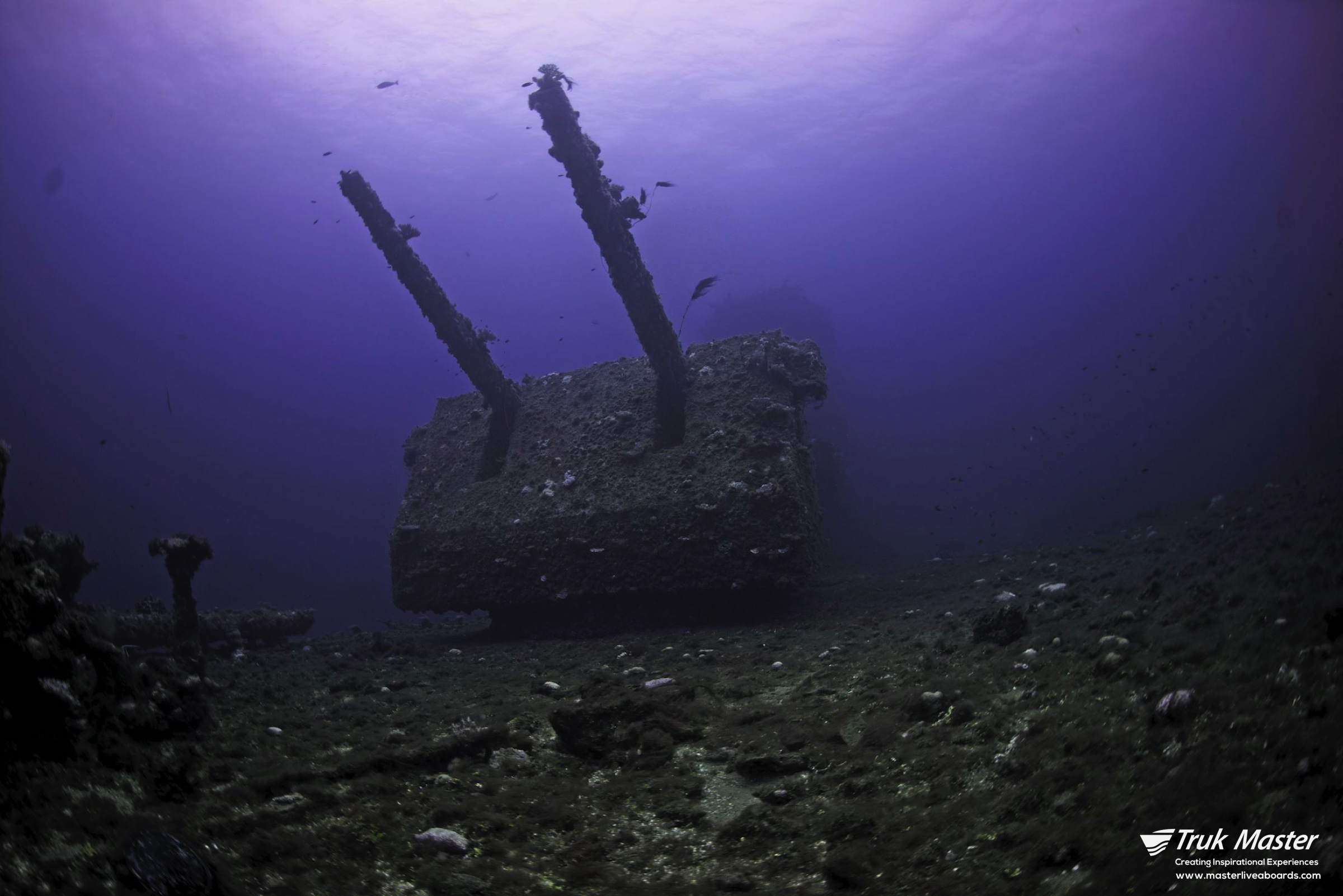Truk Master Liveaboard Diving Holiday
Depending on the season, Truk Master moves between Truk Lagoon and Bikini Atoll. This is one of the few liveaboards to dive these routes.
Built of steel, M/Y Truk Master is the newest liveaboard yacht to ply the waters of this lagoon, welcoming aboard 16 guests for 7 or 10 night Truk Lagoon dive safaris, whilst on the Bikini itineraries availability is limited as M/Y Truk Master carries 12 divers only. The 4 decks provide ample space for relaxation, dive equipment, and camera preparation, whilst the experienced crew ensures you receive only the highest quality service on your diving vacation.
 Choose between 2 world class diving locations, depending on the season.
Truk is best known for its world-class wreck diving and with over 60 wrecks, from supply vessels (Maru) to planes and a submarine, tightly packed into a coral reef lagoon. It is easy to appreciate why divers travel to this area time and time again. During WWII, the Japanese fleet used Truk as one of their main staging points for attacks on the allied forces but in 1944 the American led “Operation Hailstone” surprised the fleet resulting in the plethora of dive sites which we can see there today.
Many historical artifacts such as medicine bottles and newspapers along with articles of war, which include aircraft wings for the Zero Fighter planes, tanks, guns, gas masks and ammunition, can still be found at many of the sites., whilst the wrecks themselves are encrusted with corals, you can still clearly see telegraphs, steering columns and mounted guns. There is also the opportunity to explore engine rooms and holds. Surrounded by a coral reef, there are many
excellent coral pinnacles and deep channels with schooling pelagics too!
Bikini Atoll is part of the Republic of the Marshall Islands, which covers nearly 1 million square miles of idyllic emerald-green coral atolls, surrounded by the crystal-blue waters of the Pacific. A one of a kind diving paradise, as it features not only beautiful reefs, corals and wonderful marine life. Above all, it is the final resting place for some of the most significant warships in history. Bikini Lagoon is the first UNESCO World Heritage site for the Marshall archipelago and is undisputedly ranked first on any serious wreck divers’ bucket-list. This is well justified; nowhere else on earth will you be able to dive such a unique collection of historic battleships, cruisers, as well as the world famous USS Saratoga aircraft carrier with its 270m (888ft) flight deck.
Choose between 2 world class diving locations, depending on the season.
Truk is best known for its world-class wreck diving and with over 60 wrecks, from supply vessels (Maru) to planes and a submarine, tightly packed into a coral reef lagoon. It is easy to appreciate why divers travel to this area time and time again. During WWII, the Japanese fleet used Truk as one of their main staging points for attacks on the allied forces but in 1944 the American led “Operation Hailstone” surprised the fleet resulting in the plethora of dive sites which we can see there today.
Many historical artifacts such as medicine bottles and newspapers along with articles of war, which include aircraft wings for the Zero Fighter planes, tanks, guns, gas masks and ammunition, can still be found at many of the sites., whilst the wrecks themselves are encrusted with corals, you can still clearly see telegraphs, steering columns and mounted guns. There is also the opportunity to explore engine rooms and holds. Surrounded by a coral reef, there are many
excellent coral pinnacles and deep channels with schooling pelagics too!
Bikini Atoll is part of the Republic of the Marshall Islands, which covers nearly 1 million square miles of idyllic emerald-green coral atolls, surrounded by the crystal-blue waters of the Pacific. A one of a kind diving paradise, as it features not only beautiful reefs, corals and wonderful marine life. Above all, it is the final resting place for some of the most significant warships in history. Bikini Lagoon is the first UNESCO World Heritage site for the Marshall archipelago and is undisputedly ranked first on any serious wreck divers’ bucket-list. This is well justified; nowhere else on earth will you be able to dive such a unique collection of historic battleships, cruisers, as well as the world famous USS Saratoga aircraft carrier with its 270m (888ft) flight deck. Intinerary
Requirements: PADI Advanced Open Water or equivalent, 50 logged dives - Recommended additional 40 meter deep diver certified for recreational divers, or "PADI Tec 50" or equivalent for technical divers
Truk Lagoon
On a typical day the boat offers up to 4 day dives, however, the 4th-day dive may be substituted for a night dive when the boat is anchored within the lagoon. A 7-night itinerary provides for between 18-20 dives, whilst during the 10 night itineraries, up to 30 dives will be possible. The diving day is scheduled as follows:- Light Breakfast followed by a briefing and Dive 1
- Full Breakfast, relaxation period, briefing and Dive 2
- Lunch, relaxation period, briefing and Dive 3
- Snack relaxation period, briefing and Dive 4, where possible
- Dinner
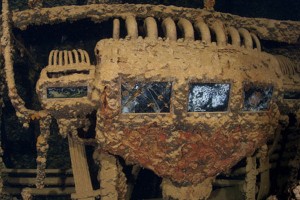 Fujikawa Maru – The armed cargo ship rests upright on the sandy bottom at 34m (110ft), rising up to 5m (15ft). She is one of the largest vessels at over 130m (430ft) in length giving plenty to explore. Decks are encrusted with corals as are her guns on the aft deck, whilst 6 holds contain a plethora of artifacts from the war, including Mitsubishi aircraft wings and Zero fighter propeller blades.
Fumitsuki – The Japanese destroyer sits upright in 38m (130ft) of water and is covered with corals attracted a wide variety of marine life. Her upper deck is at 21m (80ft) allowing recreational divers of advanced level plenty of opportunity to explore the wreckage.
Shinkoku Maru – A large oil tanker, now rests upright on the bottom encrusted with corals, sponges & hydroids. From the bridge you can see into the engine room whilst the galley still holds many utensils on the large stove. Small guns, mounted fore and aft are also covered with corals making this one of the most colourful and spectacular wrecks to be found in Truk.
Fujikawa Maru – The armed cargo ship rests upright on the sandy bottom at 34m (110ft), rising up to 5m (15ft). She is one of the largest vessels at over 130m (430ft) in length giving plenty to explore. Decks are encrusted with corals as are her guns on the aft deck, whilst 6 holds contain a plethora of artifacts from the war, including Mitsubishi aircraft wings and Zero fighter propeller blades.
Fumitsuki – The Japanese destroyer sits upright in 38m (130ft) of water and is covered with corals attracted a wide variety of marine life. Her upper deck is at 21m (80ft) allowing recreational divers of advanced level plenty of opportunity to explore the wreckage.
Shinkoku Maru – A large oil tanker, now rests upright on the bottom encrusted with corals, sponges & hydroids. From the bridge you can see into the engine room whilst the galley still holds many utensils on the large stove. Small guns, mounted fore and aft are also covered with corals making this one of the most colourful and spectacular wrecks to be found in Truk.
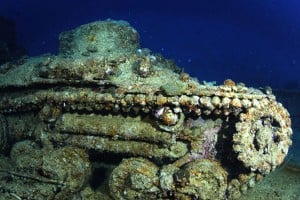 Nippo Maru – With a depth range of 24m – 42m (78ft-137ft) the Nippo is an intriguing dive site for recreational divers and tec divers alike. With a tank and howitzer guns on deck, and 5-inch guns in the holds, the Nippo is not to be missed.
Heian Maru – The largest ship in the lagoon, the Heian, originally used as a cargo ship, is 165m (510ft) in length and lies on her port side in 34m (150ft) of water. Within her holds diver may find torpedoes, shells and even the occasional periscope.
San Francisco Maru – The passenger & cargo ship, weighing 5,831 tons, lays upright at a depth of 63m (195ft). Here divers can see the remains of many well preserved war-relics including three large tanks which rest on the deck at between 46-55m (150-175ft).
Gosei Maru – A submarine tender carrying torpedoes starts in just 3m (10ft) and drops to 33m (120ft) within which can be found many personal artifacts, serving as a reminder of those who lost their lives during the battle.
Nippo Maru – With a depth range of 24m – 42m (78ft-137ft) the Nippo is an intriguing dive site for recreational divers and tec divers alike. With a tank and howitzer guns on deck, and 5-inch guns in the holds, the Nippo is not to be missed.
Heian Maru – The largest ship in the lagoon, the Heian, originally used as a cargo ship, is 165m (510ft) in length and lies on her port side in 34m (150ft) of water. Within her holds diver may find torpedoes, shells and even the occasional periscope.
San Francisco Maru – The passenger & cargo ship, weighing 5,831 tons, lays upright at a depth of 63m (195ft). Here divers can see the remains of many well preserved war-relics including three large tanks which rest on the deck at between 46-55m (150-175ft).
Gosei Maru – A submarine tender carrying torpedoes starts in just 3m (10ft) and drops to 33m (120ft) within which can be found many personal artifacts, serving as a reminder of those who lost their lives during the battle.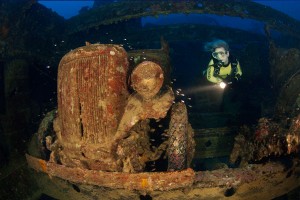 Rio de Janeiro Maru – lies on her port side at a depth of 34m (110ft) with holds containing numerous artifacts from bottles to guns. Once a luxury passenger vessel she was converted to a cargo carrier fo
r wartime and now provides divers with an easy exploration both inside and out.
Rio de Janeiro Maru – lies on her port side at a depth of 34m (110ft) with holds containing numerous artifacts from bottles to guns. Once a luxury passenger vessel she was converted to a cargo carrier fo
r wartime and now provides divers with an easy exploration both inside and out.
Bikini Atoll
The following is a sample itinerary of dive sites and wrecks you may visit during your liveaboard safari with Truk Master in Bikini Atoll. They wish to show you the very best diving possible but a number of factors can determine where they visit. Weather, tides, currents, and other factors play a part in the Cruise Director’s decision of which route the yacht takes. Whilst they attempt to ensure the number of dives we have scheduled is fulfilled, bad weather can hinder the yacht’s ability to reach a specified dive site in good time. The safety of all on board is paramount and they always do their best in offering diving at alternate locations should you be unable to visit those sites listed below. As most wrecks at Bikini Atoll are beyond recreational depth limits, this itinerary is suitable only for technical divers with previous wreck experience. Your Cruise Director will schedule 2 dives per day. The diving day has a typical schedule as follows:- Breakfast followed by a briefing & Dive 1
- Lunch, relaxation followed by briefing & Dive 2
- Snack, relaxation,
- Dinner
Cost includes
- Return transfers from local airport to the vessel on days of embarkation and disembarkation
- Full board accommodation (based on double occupancy)
- Tea
- Coffee
- Juices & soft drinks
- Up to 4 dives daily at Truk
- Single 11.1 litre (80cf) aluminium tanks (commonly called 12ltr)
- DSMB
- Weight belts and weights
Cost excludes
- Marine Park & Port Fees: Truk Lagoon 7 nights - 195 USD
- Flights
- Satellite Internet
- Rental equipment (including torch/computer/nitrox)
- Alcoholic drinks
- On board merchandise
- Crew and dive guide gratuities
- Marine Park & Port Fees
- 13.2 litre (100cf) aluminium tanks (commonly called 15ltr) are available on request (charges apply)
- Departure Tax - 30 USD
Getting to Bikini Atoll and general information
Getting there and away… Our itinerary is built around the United Airlines flight from Honolulu, Hawaii that serves both Kwajalein and Majuro. Depending on your itinerary, we highly recommend you use this flight to get to and from Kwajalein and/or Majuro. Passengers travelling from the Marshall Islands are required to pay an airport departure tax, for Kwajalein this is currently 20US$. This varies from airport to airport and must be paid in US$.
On arrival… No visa is required for entering the Marshall Islands for US citizens, EU countries, Canada and most other Western countries. Nevertheless, we recommend our guests to check for any updates and changes with their nearest Marshall Islands embassy or consulate. Please make sure that your passport is valid for at least 6 months beyond the period you intend to stay in the Marshall Islands. If you are traveling with medication, please ensure to bring your physician’s prescription with you. Please ensure you have a printed copy of the Master Liveaboards Sponsor Letter on hand when arriving in Kwajalein. Important information on arrival procedures in Kwajalein can be found here.
Staying there… The local currency in the Marshall Islands is the US Dollar (US$). Major businesses will accept credit cards; traveller’s cheques are accepted by banks and larger businesses. The number of ATMs on the islands is very limited, so we recommend bringing a sufficient amount of USD in cash, preferably in smaller denominations.
Climate and weather… The climate of the Marshall Islands is a tropical climate, with temperatures averaging between 27 and 29C (80-84F) all year round, with some trade winds and a light cooling down in the evening. Generally, the northern islands tend not to receive as much rainfall as the southern islands.
Time zone… The local time in the Marshall Islands is 12 hours ahead of UTC (GMT).
Health… In the Marshall Islands, medical care is very basic with the ‘best’ medical facility in Majuro. Any form of treatment other than basic requires evacuation. Normal precautions should be taken with food and it is advisable to drink bottled water only. No vaccinations are required before entering the Marshall Islands, however; we recommend consulting your doctor for updated information well before departure.
Radioactive radiation to which divers are exposed from the shipwrecks is negligible since water acts as an excellent insulator. Divers are safe, as long as they do not try to grab souvenirs from the wrecks. Pilfering is forbidden and hazardous.
Travel Advisories… We recommend that you book your international flight to and from Kwajalein Airport, which is served by United Airlines 3 times per week from Hawaii and takes around 7 hours. (The HNL – MAJ – KWA flight leaves on Monday, Wednesday, Friday, so generally, you will have to leave the day before that (Sunday, Tuesday, Thursday) from Los Angeles (LAX) or San Francisco (SFO) to make the connection.) Ideally, you arrive in Honolulu one day in advance of your flight to Kwajalein as this flight departs early in the morning. Keep in mind you will be crossing the date line traveling to Kwajalein Atoll. There is also a flight from Guam arriving at Kwajalein, however; we have scheduled our itinerary around the Honolulu flight.
Getting to Truk and general information
Getting there and away… M/V Truk Master embarks and disembarks at Chuuk International Airport. Book your international flight in and out of Chuuk International Airport (TKK) on Weno Island. Disembarkation at the end of the cruise will be just before 10 am. Most flights to Chuuk International Airport (TKK) require transit via Hawaii or Guam. Passengers travelling within the Federated States of Micronesia (FSM) are required to pay an airport departure tax for Chuuk, which is currently 30 US$.
Travel Advisories… Most flights to Chuuk International Airport (TKK) require transit via Guam or Hawaii, which are part of the United States. All non-US citizens must obtain a US visa or Electronic System of Travel Authorization (ESTA) prior to travel. Citizens of 37 countries, including most European nations, Australia, New Zealand, and Japan are eligible for the ESTA and should apply online at least 72 hours prior to travel. An ESTA is valid for 2 years and allows for multiple entries into US territories within that period. Guests without a visa or ESTA may be denied boarding.
On arrival… Passport holders of most western countries may obtain a visa on arrival which allows stays up to 30 days, meanwhile, travelers from the United States may obtain a tourist visa for up to 1-year stay. Please make sure that your passport has a validity of at least 4 months upon arrival into Chuuk and you are also required to show a confirmed ticket to leave Chuuk, or any country you are transiting through, prior to boarding your flight. For more information please visit the Chuuk Visitor’s Bureau.
Staying there… The local currency is the US Dollar (US$). The majority of established hotels, shops and restaurants accept major credit cards. However, smaller establishments are likely to only accept cash payments. ATMs are available however guests are advised to exchange money prior to arrival and to ensure you have small denominations on hand. We work with a number of hotels and resorts. Should you wish to extend your stay in Truk, our team will be pleased to assist you.
Climate and weather… Truk, as part of the Federated States of Micronesia (FSM) is a tropical country and the climate is fairly even all year round. The average high is 30°C (86°F) whilst the average low is 25°C (77°F) throughout the year. The more humid climate is during the summer months (Jun-Sept) whilst trade winds come mainly from the northeast between December and June.
Time zone… The local time is 10 hours ahead of UTC (GMT).
Health… Health care is readily available in the FSM and a major hospital is located within each of the states. There are no tropical diseases, however, to prevent stomach ailments we recommend travelers follow normal precautions with food and drink bottled water only. Please consult your doctor or nearest health care professional for up-to-date medical travel information well before departure. Visitors arriving from countries that are affected by Cholera or Yellow Fever must show proof of immunization upon arrival.
What dive experience level is recommended for Bikini Liveaboard trips?
Diving on the Bikini wrecks is respectfully recommended for technical divers only with a minimum of PADI Tec 50 level or equivalent, with wreck experience, as the average depth of the wrecks is around 50 meters (150 ft). To get the most out of your dives in Bikini Atoll, highly recommended are:
TDI – Advanced Nitrox & Deco Procedures
IANTD – Tech Nitrox
NAUI – Tech Nitrox & Deco Techniques
ANDI – Technical Nitrox

